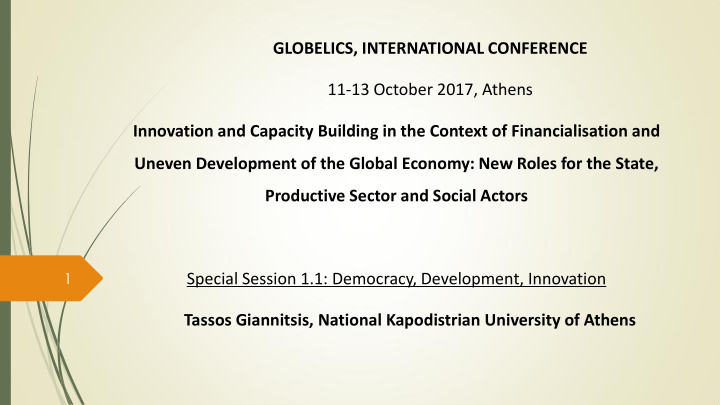



GLOBELICS, INTERNATIONAL CONFERENCE 11-13 October 2017, Athens Innovation and Capacity Building in the Context of Financialisation and Uneven Development of the Global Economy: New Roles for the State, Productive Sector and Social Actors 1 Special Session 1.1: Democracy, Development, Innovation Tassos Giannitsis, National Kapodistrian University of Athens
Five points: 2 1. Development and inequality. Overall, in today ’ s industrialised world we can see three major rifts that break the linear process of development and affect inequality relationships. The first rift comes from ‘outside’ : since the early 1970s, the developed world has been faced with a changing global landscape. A number of emerging countries have strengthened their position in the world system, irreversibly changing the game. The global distribution of income, wealth, power and development capabilities has changed dramatically. The new world balance causes destabilising trends that affect economic and social balances, institutions and the political system, in several industrialized countries.
3 The second rift comes from ‘within’. K ey growth tools, such as technological change, innovation, policy choices, institutions, which for decades underpinned the growth momentum of the industrialised countries, have weakened and lead to flat income changes and stronger within-country inequalities. Innovation and technological change have introduced growing divides between those social segments that have the knowledge and skills to handle the new key drivers of development and those that are trapped in low-skill and declining activities. Equally, an internal redistribution of income has taken place between dynamic and declining sectors and high-skilled and low-skilled employees, at the expense of the latter who often remain excluded from even the limited increase in GDP.
4 Higher inequalities in an environment of lower growth have altered the nature of inequality itself. Besides being a major social issue, inequality has emerged as a significant destabilising factor for both the Macro-economy and Democracy. Inequality, as measured by the Gini coefficient, refers to total inequality. Often, such aggregate figures mask major positive or negative within individual sub- groups.
5 A third factor behind the growing within-country inequalities refers to deregulated financial globalisation. Financial globalisation exerts significantly different effects than trade and investment globalisation. A comparison between the Tequila crisis (1994) and the sub-prime and euro crises of the years 2007-2011 reveals crucial differences. The explosive expansion of deregulated financial globalisation led to unprecedented capital and income profits and gains for the financial sector and the actors involved in these activities. It also led to unprecedented destabilisation on a global scale.
6 2. Internal power balances and national policy choices. To a great extent, the worsening of this inequality is linked to national choices and policies, such as the significant cuts in tax rates on higher incomes, the deregulation of labour markets, the inefficient restructuring policies and the increasing use of borrowing as a tool for a temporary improvement in the living standards of parts of the population. The difference in the level and change of inequality between the US and the UK, on the one hand, and most European countries, on the other, is striking: in the latter group of countries, policy succeeded in containing both the level and the rise of inequality, meaning that political and social choices coupled with social, tax and redistributive policies can mitigate the internal inequalities and the disruptive impact of external factors.
7 3. Technological change, Development and Democracy. Technological progress and innovation were expected to bring about high growth rates and support industrialized countries to maintain their relative lead in the global arena. Today, we see that the growth-enhancing impact of technological change has diminished. Further, the weakening impact of innovation on productivity in advanced countries motivated destructive financial innovations, including sub-prime loans and bonds. Such innovations were used as a tool to reinforce growth and profits, but in the medium term, they proved to generate a wider crisis and destabilisation. A central question is why, despite technological advances, productivity growth is so slow or even negative. Perhaps we are faced with a measurement problem. We need to reconsider the quantitative and qualitative conditions of growth under new conditions.
8 4. Through different paths we reach the same result: weak growth, flat incomes for broader segments of society, increasing indebtedness, coupled with increased inequalities, lower social protection, leading to a retrenchment to more conservative choices, especially in privileged societies which, although they are still at the top of the global income hierarchy, realise that their heyday will soon be over. As in the past, the future of Democracy and Development is inextricably tied with innovation and knowledge-based activities. The impact of energy, climate change, ageing or other uncertainties depends on new technological and social innovations. A fall into stagnant or declining growth would lead to stronger inequalities and severe changes, with far-reaching and unknown effects on Democracy and basic values of our societies.
9 5. The ever-present contradiction: The Good and the Evil The historical transition of many poor countries from stagnation or decline to a path of development is irreversible. Therefore, in today’s setting we are witnessing a sharp ideological contradiction: according to the mainstream perception, as long as market deregulation and globalisation were supposed to benefit all – the rich and the weak alike – they were seen as the Good. In spite of their inability to compete with developed countries, Third World countries had to accept the rules of deregulated markets. When it became clear that the development of their production and knowledge capabilities could take place even in open market conditions, thereby tipping the balances of power and putting pressure on prices and incomes in developed countries, then new ideologies came into play. The development of these countries began to be perceived as a threatening Evil and as warranting protectionism and conflict between the thriving, the striving and the in between.
Recommend
More recommend